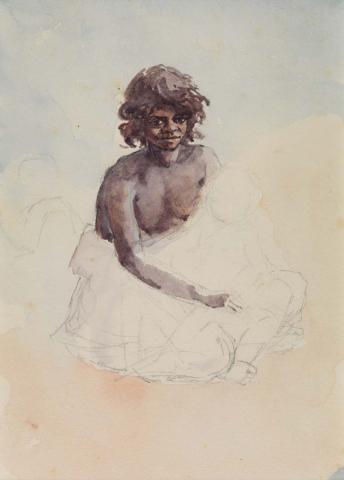DIDACTIC: Harriet Jane Neville-Rolfe
In 1883, the aristocratic young British artist Harriet Jane Neville-Rolfe travelled to visit her family in Australia. Over two years, she recorded life on Alpha Station, central Queensland, in vivid washes of watercolour. Flowers, fruit and natural scenes abound. Neville-Rolfe’s work also includes sensitive portrayals of First Nations family groups, including an unfinished image of a young Aboriginal woman with a toddler on her lap — her own Madonna and Child. Some of her settings are genteel, but with an edge: the breakfast table of the raw timber-walled homestead at Alpha is set with a white tablecloth and silverware; on the walls, art hangs alongside weapons.
In contrast with this stately abundance, Neville-Rolfe’s Castlevale 1884 depicts a First Nations family group gathered around twin campfires. A man lies partially covered by a government-issued blanket. This was a period of turmoil — disease, death and displacement. Even looking closely, we cannot be sure if this is a scene of rest or impending sorrow.
Art can carry difficult historical truths: sometimes these are consciously framed and sometimes they are quietly carried through time, awaiting our attention. These watercolours act as witnesses to the founding aspirations of Australia as a nation and the complex inheritances since, including the silences we still work to reconcile.
Connected objects

Castlevale 1884
- NEVILLE-ROLFE, Harriet Jane - Creator
Related artists
Digital Stories highlighting this narrative
![An installation view of ‘Plenty’, featuring the Gallery’s [Frame] 1959 by James Bourlet & Sons, London; and the 1860 Tower carbine rifle comprising Repatriation effort: this is not mine to bear 2016 by artist d harding (Bidjara/Ghungalu/ Garibal peoples) / Courtesy: The artist and Milani Gallery, Brisbane / Photograph: C Callistemon, QAGOMA An installation view in a dark room with gallery walls painted black; an empty gold frame on the wall, in the centre of the photo, frames the darkness; beneath it, a rifle is displayed in a glass cabinet.](/index.php/system/files/styles/large/private/2023-10/QAG_G7-9_installationview_20230403_ccallistemon_011.jpg?itok=wWGaxSBE)
ESSAY: ‘Plenty’
Read digital storyMetadata, copyright and sharing information
About this story
- Subject

